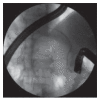Endoscopic pancreatic duct stent placement for inflammatory pancreatic diseases
- PMID: 18023085
- PMCID: PMC4250876
- DOI: 10.3748/wjg.v13.45.5971
Endoscopic pancreatic duct stent placement for inflammatory pancreatic diseases
Abstract
The role of endoscopic therapy in the management of pancreatic diseases is continuously evolving; at present most pathological conditions of the pancreas are successfully treated by endoscopic retrograde cholangio-pancreatography (ERCP) or endoscopic ultrasound (EUS), or both. Endoscopic placement of stents has played and still plays a major role in the treatment of chronic pancreatitis, pseudocysts, pancreas divisum, main pancreatic duct injuries, pancreatic fistulae, complications of acute pancreatitis, recurrent idiopathic pancreatitis, and in the prevention of post-ERCP pancreatitis. These stents are currently routinely placed to reduce intraductal hypertension, bypass obstructing stones, restore lumen patency in cases with dominant, symptomatic strictures, seal main pancreatic duct disruption, drain pseudocysts or fluid collections, treat symptomatic major or minor papilla sphincter stenosis, and prevent procedure-induced acute pancreatitis. The present review aims at updating and discussing techniques, indications, and results of endoscopic pancreatic duct stent placement in acute and chronic inflammatory diseases of the pancreas.
Figures












References
-
- Ishihara T, Yamaguchi T, Seza K, Tadenuma H, Saisho H. Efficacy of s-type stents for the treatment of the main pancreatic duct stricture in patients with chronic pancreatitis. Scand J Gastroenterol. 2006;41:744–750. - PubMed
-
- Widdison AL, Alvarez C, Karanjia ND, Reber HA. Experimental evidence of beneficial effects of ductal decompression in chronic pancreatitis. Endoscopy. 1991;23:151–154. - PubMed
-
- Boerma D, van Gulik TM, Rauws EA, Obertop H, Gouma DJ. Outcome of pancreaticojejunostomy after previous endoscopic stenting in patients with chronic pancreatitis. Eur J Surg. 2002;168:223–228. - PubMed
-
- Adler DG, Lichtenstein D, Baron TH, Davila R, Egan JV, Gan SL, Qureshi WA, Rajan E, Shen B, Zuckerman MJ, et al. The role of endoscopy in patients with chronic pancreatitis. Gastrointest Endosc. 2006;63:933–937. - PubMed
-
- Díte P, Ruzicka M, Zboril V, Novotný I. A prospective, randomized trial comparing endoscopic and surgical therapy for chronic pancreatitis. Endoscopy. 2003;35:553–558. - PubMed
Publication types
MeSH terms
LinkOut - more resources
Full Text Sources
Medical

